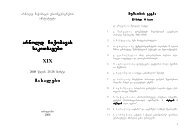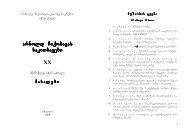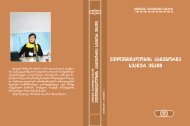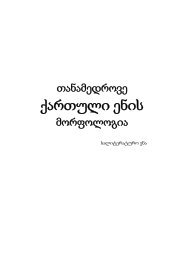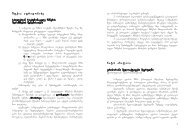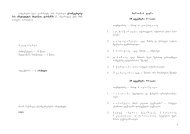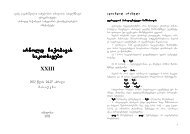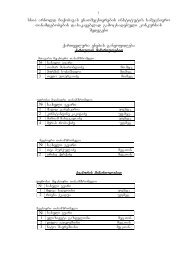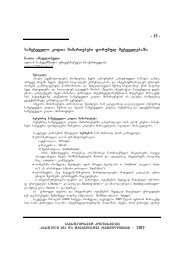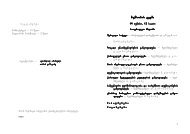5 r. a b a S i a (Tbilisi) bgeraTSesatyvisobis erTi rigisaTvis qarTvelur ...
5 r. a b a S i a (Tbilisi) bgeraTSesatyvisobis erTi rigisaTvis qarTvelur ...
5 r. a b a S i a (Tbilisi) bgeraTSesatyvisobis erTi rigisaTvis qarTvelur ...
You also want an ePaper? Increase the reach of your titles
YUMPU automatically turns print PDFs into web optimized ePapers that Google loves.
able to record on audiotape a few Tavsili versions of the Book of Genesis. The<br />
full text along with its commentary will be published in the nearest future<br />
(copies should be available for the conference).<br />
The entire text has been recorded from one Rabbi, while some portions of<br />
the text have been recorded from two additional Rabbis. Tavsili is extremely<br />
important for the study of translations of the Old Testament, especially the oral<br />
translations. In addition, it is just as important for the study of history of<br />
Georgian language and it’s dialects.<br />
By our estimation, the translation was created in 11 th - 12 th centuries. As<br />
previously mentioned, it has been orally transmitted throughout the generations<br />
and has survived until the present time (although the traditional text is in clear<br />
danger of being forgotten.) Rabbis and their students were studying the text for<br />
years trying to preserve its original form. However, it is clear that the text<br />
wasn’t entirely transmitted in its original form due to multiple reasons.<br />
First, due to the Rabbis’ limited general educational level (or their<br />
knowledge of literal language), and their memory. Furthermore, due to changes<br />
in daily speech, influences of local dialects and their poor knowledge of Hebrew<br />
language, etc.<br />
The importance of Tavsili for Georgian linguistics is immense. It is one<br />
of the rarest samples of historic, life speech. Its proper research will help us in<br />
the study of the history of the Georgian language and its dialects.<br />
During the presentation, a couple of examples will be given, which will<br />
help us understand how Tavsili can be used to view the changes that took place<br />
in the Georgian language.<br />
1. Article; Tavsili uses the article without limits. It’s clear that this is due<br />
to the influence of Hebrew. On the other hand, it’s also apparent, that at the time<br />
of creation of this translation the article has been actively used in Georgian,<br />
although, the process of changing the rules of its use has already begun. This<br />
pertains to the location of the article as well as its uses with Proper Names, etc;<br />
2. Use of Stem Case forms and their gradual change to Nominative or<br />
Ergative Cases. For example in the same verse we have two different forms –<br />
“Terax deebada igi Abram” and “deebada igi Abrami”.<br />
3. Directional Case Forms – for example, suqota. Suqot is the name of<br />
the place.<br />
157



